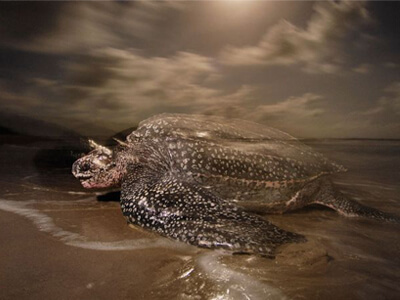Leatherback Sea Turtles Fast Facts
Type: Reptile
Diet: Carnivore
Average life span in the wild: 45 years (est.)
Size: Up to 7 ft (2 m)
Weight: Up to 2,000 lbs (900 kg)
Protection status: Endangered
Size relative to a 6-ft (2-m) man:

Did you know?
Leatherbacks are the largest turtles on Earth, growing up to seven feet (two meters) long and exceeding 1,000 pounds (450 kilograms). These reptilian relics are the only remaining representatives of a family of turtles that traces its evolutionary roots back more than 100 million years. Once prevalent in every ocean except the Arctic and Antarctic, the leatherback population is rapidly declining in many parts of the world.
While all other sea turtles have hard, bony shells, the inky-blue carapace of the leatherback is somewhat flexible and almost rubbery to the touch. Ridges along the carapace help give it a more hydrodynamic structure. Leatherbacks can dive to depths of 4,200 feet (1,280 meters)—deeper than any other turtle—and can stay down for up to 85 minutes.
Leatherbacks have the widest global distribution of all reptile species, and possibly of any vertebrate. They can be found in the tropic and temperate waters of the Atlantic, Pacific, and Indian Oceans, as well as the Mediterranean Sea. Adult leatherbacks also traverse as far north as Canada and Norway and as far south as New Zealand and South America. Unlike their reptilian relatives, leatherbacks are able to maintain warm body temperatures in cold water by using a unique set of adaptations that allows them to both generate and retain body heat. These adaptations include large body size, changes in swimming activity and blood flow, and a thick layer of fat.
Leatherbacks undertake the longest migrations between breeding and feeding areas of any sea turtle, averaging 3,700 miles (6,000 kilometers) each way. After mating at sea, females come ashore during the breeding season to nest. The nighttime ritual involves excavating a hole in the sand, depositing around 80 eggs, filling the nest, leaving a large, disturbed area of sand that makes detection by predators difficult, and finally returning to the sea.
The temperature inside the nest determines the sex of the hatchlings. A mix of male and female hatchlings occurs when the nest temperature is approximately 85.1 degrees Fahrenheit (29.5 degrees Celsius), while higher temperatures produce females and cooler temperatures produce males. Female hatchlings that make it to sea will roam the oceans until they reach sexual maturity, when they return to the same nesting areas to produce their own offspring. Males spend the rest of their lives at sea.
Their lifespan is unknown but many leatherbacks meet an early end due to human activity. It is estimated that only about one in a thousand leatherback hatchlings survive to adulthood. Eggs are often taken by humans from nests to be consumed for subsistence or as aphrodisiacs. Many leatherbacks fall victim to fishing lines and nets, or are struck by boats. Leatherbacks also can die if they ingest floating plastic debris mistaken for their favorite food: jellyfish. Some individuals have been found to have almost 11 pounds (5 kilograms) of plastic in their stomachs.
Leatherbacks are currently designated as endangered under the U.S. Endangered Species Act. The number of leatherbacks in the Atlantic appears to be stable or increasing, but the Pacific population is declining at an alarming rate due to egg harvest, fishery by catch, coastal development, and highly variable food availability. Some Pacific populations have disappeared entirely from certain areas, such as Malaysia.
Scientists around the world are tracking and studying leatherbacks to learn more about these reptilian giants and how they can be saved.

